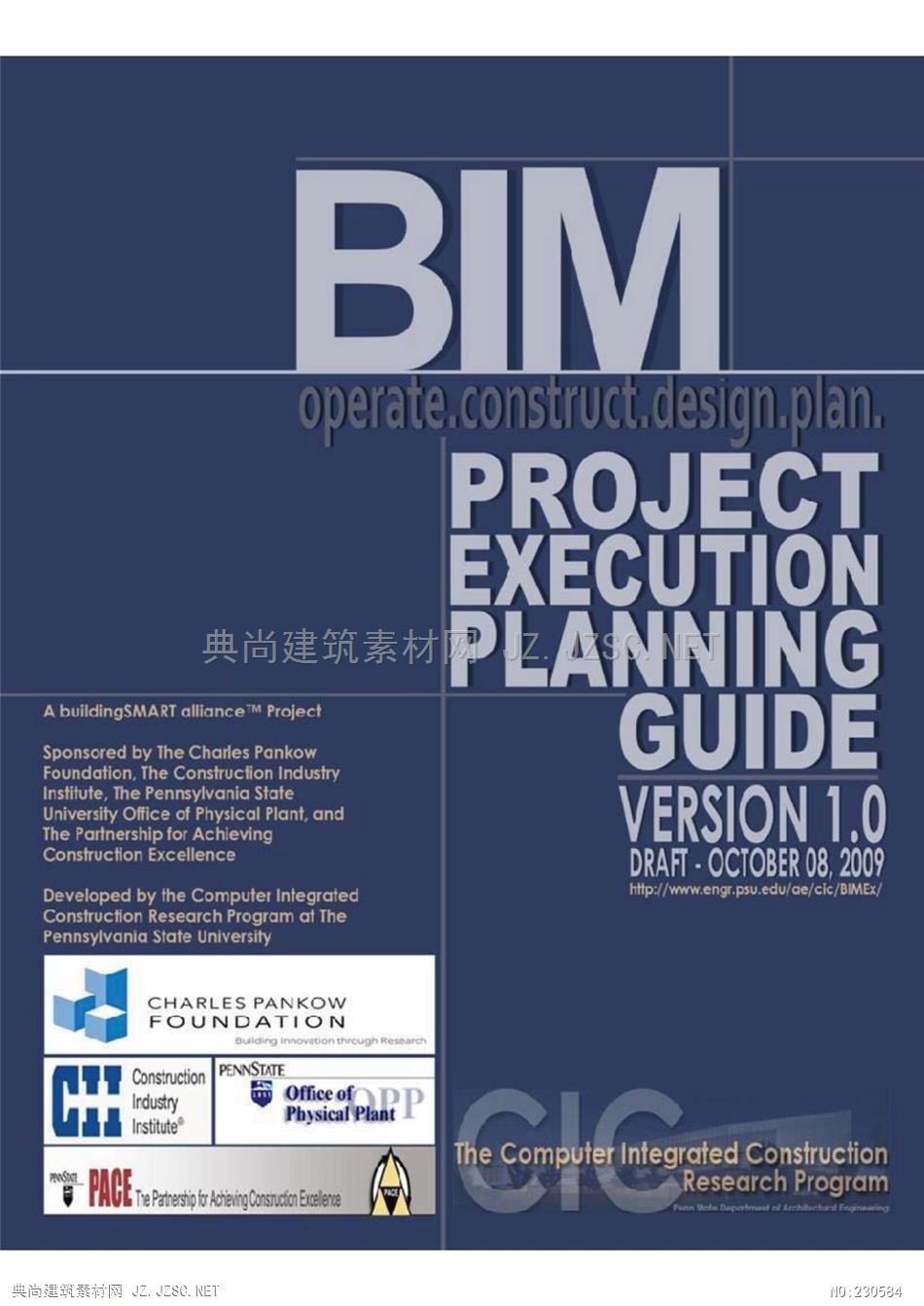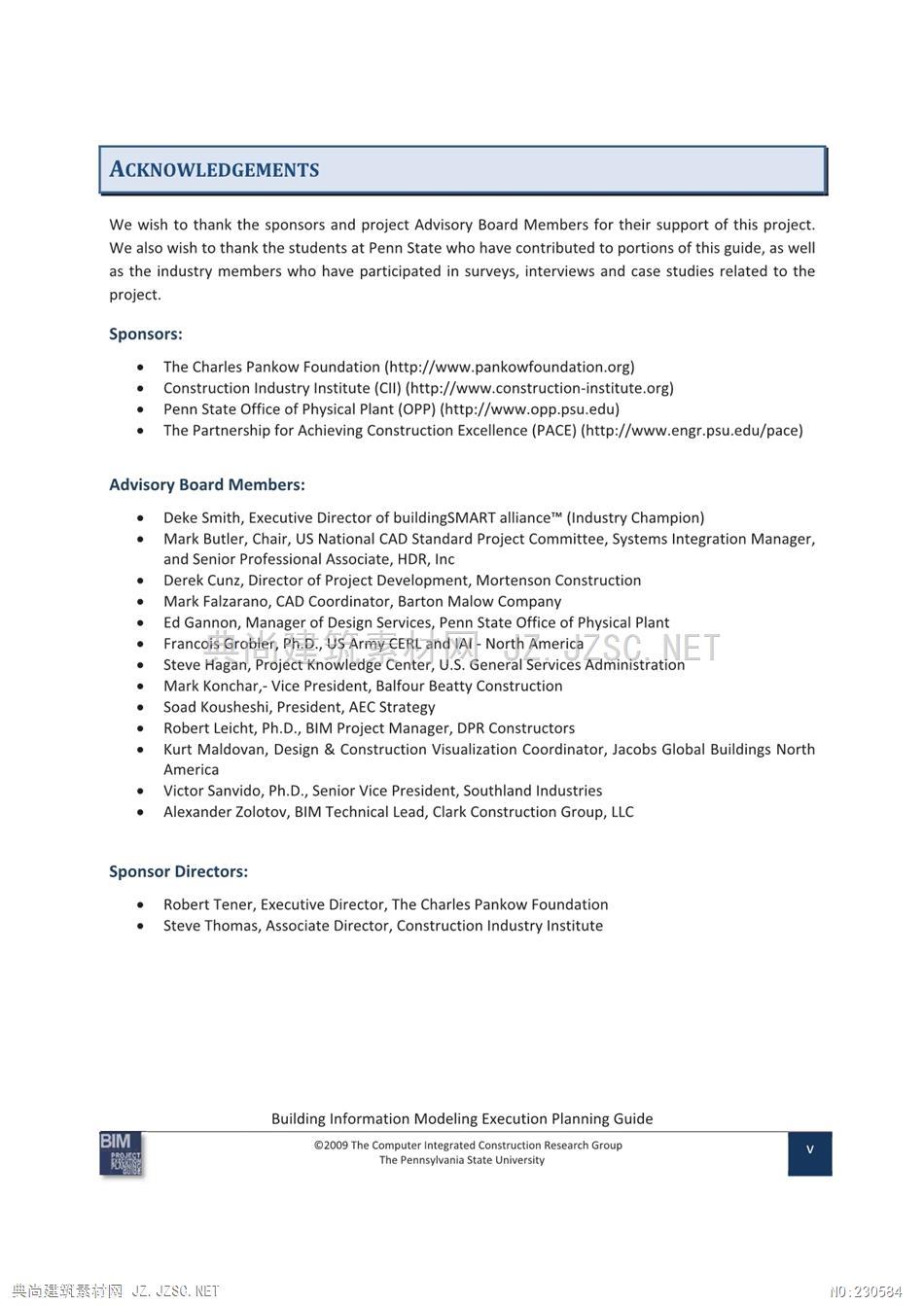









EXECUTIVE SUMMARYA Building Information Model(BIM)is"a digital representation of physical and functional characteristicsof a facility.To successfully implement BIM on a project,the project team must perform detailed andcomprehensive planning.The team should document the plans into a BIM Project Execution Plan toensure that all parties are clearly aware of the opportunities and responsibilities associated with theincorporation of BIM into the project workflow.The BIM Project Execution Plan should define theappropriate uses for BIM on the project (e.g.,design authoring,cost estimating,and designcoordination),along with a detailed design of the process for executing BIM throughout the projectlifecycle.Once the plan is created,the team can follow and monitor their progress against this plan togain the maximum benefits from BIM implementation.This Guide provides a structured procedure,as displayed in figure i-1,for creating and implementing aBIM Project Execution Plan.The four steps within the procedure include:1)Identify high value BIM uses during project planning,design,construction and operationalphasesDesign the BIM execution process by creating process maps3Define the BIM deliverables in the form of information exchanges4)Develop the infrastructure in the form of contracts,communication procedures,technologyand quality control to support the implementationBIM Project Execution Planning ProcedureDefine project and team valueIdentify BIM Goalsthrough the identification of BIMand UsesGoals and Uses,Develop a process which includesDesign BIM ProjectExecution Processtasks supported by BIM along with-information exchanges.T世TBIMDevelop InformationDevelop the information contentlevel of detail and responsibleExchangesparty for each exchange.Define SupportingDefine the project infrastructureInfrastructure for BIMrequired to support the developedImplementationBIM process.Figure i-1:The BIM Project Execution Planning Procedure1 Readers who are not familiar with these concepts should first review the National Building InformationModeling Standard,Part 1 available at www.buildingsmartalliance.org/nbims.Building Information Modeling Execution Planning GuideBIM2009 The Computer Integrated Construction Research GroupThe Pennsylvania State University筑Z沁.ET AUTHORS AND CONTRIBUTORSThe guide was authored by a team of individuals within the Computer Integrated Construction(CIC)Research Program at Penn State.Principle authors of the guide in alphabetical order include:Chimay Anumba,Professor and Head,Department of Architectural Engineering,Penn StateCraig Dubler,Graduate Research Assistant,Penn StateShane Goodman,former MAE/BAE student,Penn StateColleen Kasprzak,Graduate Research Assistant,Penn StateRalph Kreider.Graduate Research Assistant.Penn StateJohn Messner,Director,CIC Research Program and Associate Professor of ArchitecturalEngineering,Penn StateChitwan Saluja,Graduate Research Assistant,Penn StateNevena Zikic,former Graduate Research Assistant,Penn StateContact information for the above authors can be found at the Computer Integrated ConstructionResearch Program website (www.engr.psu.edu/ae/cic/).Additional Contributors:.Project Advisory Board Members (see Acknowledgements)Students in the 2008 Penn State AE 597F Graduate Class on BIM Execution PlanningCitation for this Document:Computer Integrated Construction Research Program.(2009)."BIM Project Execution Planning Guide-Version 1.0."October 8,The Pennsylvania State University,University Park,PA,USA.Building Information Modeling Execution Planning GuideBIM2009 The Computer Integrated Construction Research Group拼The Pennsylvania State University理筑素前阀Z.ZC.ET ACKNOWLEDGEMENTSWe wish to thank the sponsors and project Advisory Board Members for their support of this project.We also wish to thank the students at Penn State who have contributed to portions of this guide,as wellas the industry members who have participated in surveys,interviews and case studies related to theproject.Sponsors:The Charles Pankow Foundation(www.pankowfoundation.org)Construction Industry Institute(Cll)(www.construction-institute.org)Penn State Office of Physical Plant(OPP)(www.opp.psu.edu)The Partnership for Achieving Construction Excellence(PACE)(www.engr.psu.edu/pace)Advisory Board Members:Deke Smith,Executive Director of buildingSMART allianceTM(Industry Champion)Mark Butler,Chair,US National CAD Standard Project Committee,Systems Integration Manager,and Senior Professional Associate,HDR,IncDerek Cunz,Director of Project Development,Mortenson ConstructionMark Falzarano,CAD Coordinator,Barton Malow CompanyEd Gannon,Manager of Design Services,Penn State Office of Physical PlantFrancois Grobier,Ph.D.Us Army CERL and IAl-North AmericaSteve Hagan,Project Knowledge Center,U.S.General Services AdministrationMark Konchar,-Vice President,Balfour Beatty ConstructionSoad Kousheshi,President,AEC StrategyRobert Leicht,Ph.D.,BIM Project Manager,DPR ConstructorsKurt Maldovan,Design Construction Visualization Coordinator,Jacobs Global Buildings NorthAmericaVictor Sanvido,Ph.D.,Senior Vice President,Southland IndustriesAlexander Zolotov,BIM Technical Lead,Clark Construction Group,LLCSponsor Directors:Robert Tener,Executive Director,The Charles Pankow FoundationSteve Thomas,Associate Director,Construction Industry InstituteBuilding Information Modeling Execution Planning GuideBIM2009 The Computer Integrated Construction Research GroupThe Pennsylvania State University理筑素前阀Z.ZC.ET 1OVERVIEW OF THE PROJECT EXECUTION PLANNING PROCEDURE FORBUILDING INFORMATION MODELING1.Introduction to Building Information ModelingBuilding Information Modeling (BIM)is a process focused on the development,use and transfer of adigital information model of a building project to improve the design,construction and operations of aproject or portfolio of facilities.The National Building Information Modeling Standards (NBIMS)Committee defines BIM as:"a digital representation of physical and functional characteristics of a facility.A BIM is ashared knowledge resource for information about a facility forming a reliable basis fordecisions during its life-cycle;defined as existing from earliest conception to demolition.Abasic premise of BIM is collaboration by different stakeholders at different phases of the lifecycle of a facility to insert,extract,update or modify information in the BIM to support andreflect the roles of that stakeholder."3When properly implemented,BIM can provide many benefits to a project.The value of BIM has beenillustrated through well planned projects which yield increased design quality through effective analysiscycles;greater prefabrication due to predictable field conditions;improved field efficiency by visualizingthe planned construction schedule;increased innovation through the use of digital design applications;and many more.At the end of the construction phase,valuable information can be used by the facilityoperator for asset management,space planning,and maintenance scheduling to improve the overallperformance of the facility or a portfolio of facilities.Yet,there have also been examples of projectswhere the team did not effectively plan the implementation of BIM and incurred increased costs for themodeling services,schedule delays due to missing information,and little to no added value.Implementing BIM requires detailed planning and fundamental process modifications for the projectteam members to successfully achieve the value from the available model information.BIM can be implemented at many phases throughout a project,but the current technology,training,andcosts of implementation relative to added value must always be considered when determining theappropriate areas and levels of detail needed in the information modeling processes.Teams should notfocus on whether or not to use BIM in general,but instead they need to define the specificimplementation areas and uses.A team should aim to implement BIM at the level needed to maximizevalue while minimizing the cost and impact of the modeling implementation.This requires the team toselectively identify appropriate areas for BIM implementation and plan these implementation areas indetail.NBIMS,2007 available at www.wbdg.org/pdfs/NBIMSv1_p1.pdf.Building Information Modeling Execution Planning Guide2009 The Computer Integrated Construction Research GroupThe Pennsylvania State University3筑素前网Z沁.ET 2.Why Should the Project Team Develop a BIM Project Execution Plan?To effectively integrate BIM into the project delivery process,it is important for the team to develop adetailed execution plan for BIM implementation.A BIM Project Execution Plan (hereinafter referred toas the 'BIM Plan')outlines the overall vision along with implementation details for the team to followthroughout the project.The BIM Plan should be developed in the early stages of a project;continuallydeveloped as additional participants are added to the project;and monitored,updated,and revised asneeded throughout the implementation phase of the project.The plan should define the scope of BIMimplementation on the project,identify the process flow for BIM tasks,define the informationexchanges between parties,and describe the required project and company infrastructure needed tosupport the implementation.By developing a BIM Plan,the project and project team members can achieve the following value:1.All parties will clearly understand and communicate the strategic goals for implementing BIM onthe project;2.Organizations will understand their roles and responsibilities in the implementation;3.The team will be able to design an execution process which is well suited for each teammember's business practices and typical organizational workflows;4.The plan will outline additional resources,training,or other competencies necessary tosuccessfully implement BIM for the intended uses;5.The plan will provide a benchmark for describing the process to future participants who join theoecJ.NE6.The purchasing divisions will be able to define contract language to ensure that all projectparticipants fulfill their obligations;and7.The baseline plan will provide a goal for measuring progress throughout the project.BIM,like other new technologies,can carry some level of additional process risk when implemented byteams that are not experienced with the implementation process,or if people are not familiar with thestrategies and processes of their team members.Ultimately,the entire team will gain value through theincreased level of planning by reducing the unknowns in the implementation process thereby reducingthe overall risk to all parties and the project.3.The BIM Project Execution Planning ProcedureThis guide outlines a four step procedure to develop a detailed BIM Plan.The procedure is designed tosteer owners,program managers,and early project participants through a structured process to developdetailed,consistent plans for projects.This procedure was developed through a multi-step researchprocess which included industry interviews with over 40 industry experts,detailed analysis of existingplanning documents,focus group meetings with industry participants,process mapping research todesign an efficient and effective mapping structure,and case study research to validate the procedure.Building Information Modeling Execution Planning Guide2009 The Computer Integrated Construction Research GroupThe Pennsylvania State University理筑素衬阀Z.Z0.ET
本站所有资源由用户上传,仅供学习和交流之用;未经授权,禁止商用,否则产生的一切后果将由您自己承担!素材版权归原作者所有,如有侵权请立即与我们联系,我们将及时删除